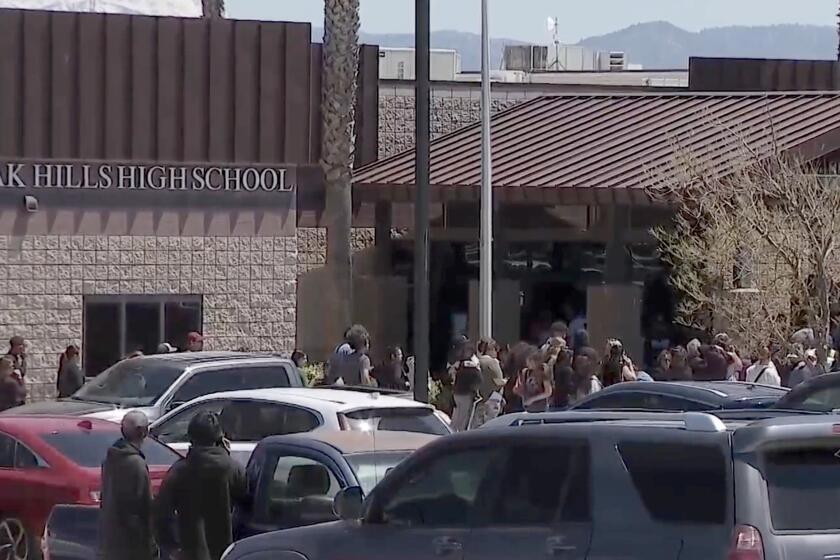California’s cap-and-trade program is key to Gov. Jerry Brown’s agenda
For Gov. Jerry Brown, fighting climate change is more than a central tenet of his political agenda. It’s also a key source of funding.
California’s cap-and-trade program, in which permits to pollute are traded and fees are levied, has been a swelling source of revenue, helping to fuel major initiatives in the updated spending blueprint released by the governor this week.
Money from the pollution fund is already being used to install rooftop solar panels, start bullet train construction in the Central Valley and put more clean vehicles on California roads.
Now, Brown is proposing that it also finance anti-drought efforts, such as helping Californians replace outdated appliances and investing in more efficient water projects.
Simply put: When power plants burn fuel and tailpipes spew exhaust, money is pumped into the governor’s agenda.
All revenue from cap and trade must, by law, be used to reduce greenhouse gas emissions, the goal of the legislation that created the program. Brown and lawmakers have cited overlap between pollution reduction and a variety of goals that, at first glance, may not seem directly related.
“This has become a Christmas tree of spending,” said Bill Whalen, a fellow at Stanford’s Hoover Institution who was a speechwriter for former Republican Gov. Pete Wilson. “It’s like modern art. You can look at it and interpret it any way you want.”
Brown’s funding strategy carries some risk. Lawsuits are pending that challenge the legality of the cap-and-trade program and Brown’s decision to use some of the revenue for the bullet train.
The governor’s finance director, Michael Cohen, rejected legal concerns in discussing the budget Thursday, saying, “We’re confident that everything in this plan is legal.”
Brown views the cap-and-trade program as a model for other states and countries, touting its ability to reduce emissions as world leaders plan to convene in Paris later this year to discuss new steps against climate change.
“Carbon pollution is still rising worldwide,” the governor said Thursday. “And so, one of the principal strategies is to put a price on carbon, and a price that will rise to increase the burden of using carbon.”
For California’s government, putting a price on carbon has been lucrative. The governor expects to have $2.2 billion from the pollution fund to spend in the fiscal year that begins July 1 — more than double what was available last year. Revenue has surged because cap and trade now applies to transportation fuels, the source of roughly 40% of the state’s carbon emissions.
An annual framework for spending the money was included in last year’s budget. Each year, the $68-billion bullet train will receive 25%, while 35% goes to affordable housing and other transportation programs.
Securing annual funding for high-speed rail — which was awarded $250 million in the last budget and stands to receive $500 million in the next — was a key victory for Brown.
“It’s helping to leverage private-sector interest,” said Lisa Marie Alley, a spokeswoman for the statewide project.
The money arrived when state cash was needed to match federal funding for the project but voter-approved bonds to finance it were tied up by lawsuits.
From last July through March of this year, almost every dollar of the nearly $200 million spent on the bullet train has come from the cap-and-trade program.
That funding is controversial because, as nonpartisan legislative analysts have warned, the process of building the train could increase greenhouse gas emissions over the next several years – a contradiction of the cap-and-trade goal.
The argument is being used by an opponent of high-speed rail who has sued to block the funding. Administration officials have defended their plans by saying the train itself, which will run on electricity, will reduce emissions in the long run.
Another beneficiary of cap-and-trade funding has been affordable housing. Last year’s budget included $130 million of the funds for that cause, and Brown’s latest budget proposal would add another $400 million.
Projects using the money are supposed to be built in ways that encourage public transportation, walking or biking, and a government commission is scheduled to announce the first grants this summer.
Matt Schwartz, president of the advocacy group California Housing Partnership, said the funding won’t replace what was lost when redevelopment agencies that subsidized revival of blighted areas were eliminated.
However, he said, limitations on using cap-and-trade money have spurred beneficial cooperation with groups fighting climate change.
“It’s forced us to work together to consider environmental climate impacts as we plan affordable housing,” he said. “There’s huge benefits to this.”
Former Senate leader Darrell Steinberg, a Sacramento Democrat who worked with the governor on cap-and-trade spending last year, said lawmakers were careful to make sure all dollars contributed to reducing emissions.
“Once that definition is met, I think it’s an added benefit that we can also address some of the other priorities,” he said.
Finding ways to creatively match the funding to the state’s needs is “the art of good government,” Steinberg said.
Forty percent of cap-and-trade revenue is up for grabs each year — some of which Brown wants to tap now for drought relief.
About $120 million of his $2.2-billion plan for fighting the drought comes from cap and trade. Part of that money could be used for rebates to consumers who, for example, invest in new dishwashers that use less water and energy.
“That’s a perfect example of what I think is an easy call,” said Cara Horowitz, co-director of UCLA’s Environmental Law Clinic. “You’re increasing energy efficiency, reducing climate pollution and helping us adapt to a reality with less water.”
It’s an open question how long the money will last, however. A lawsuit by the California Chamber of Commerce calls the program an illegal tax. A state judge rejected that assertion in 2013, but an appeal is pending.
Loren Kaye, president of the California Foundation for Commerce and Education, a think tank affiliated with the Chamber, was asked for an opinion on how Brown is using the revenue.
“We don’t really have an opinion on how he’s spent the money,” he said, “because we don’t think he should have the money in the first place.”
Twitter: @chrismegerian
More to Read
Start your day right
Sign up for Essential California for news, features and recommendations from the L.A. Times and beyond in your inbox six days a week.
You may occasionally receive promotional content from the Los Angeles Times.







